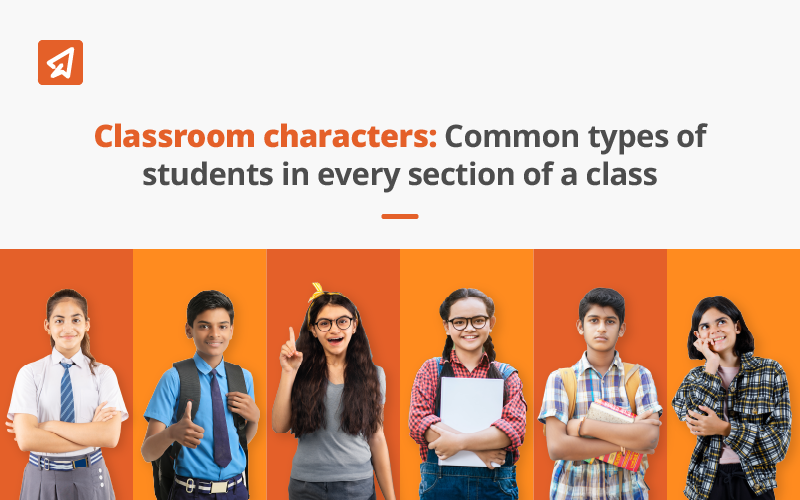Classroom characters: Common types of students in every section of a class

Every class is like a mix of different people, each with their strengths and weaknesses. As teachers, our goal is to make a place where all students can do well and be their best.
It’s important to know the different kinds of students in our classes and how they learn best. Some students learn better when they see things, while others like to figure things out on their own. Each type of student adds something special to the learning process.
In this article, we’ll look at the different types of students in our classrooms and talk about the best ways to teach them. When you know the different types of students in your class, you can make a place where everyone feels helped and can do their very best. Keep reading to find out more about each category of students.
Types of Students in a Classroom

-
The Perfectionist
A perfectionist student is someone who always wants to do their best in everything. They feel proud of their work and work hard to finish tasks perfectly. Perfectionists care a lot about doing things right and are ready to put in extra effort to make sure everything is correct.
They’re super organized and often make detailed plans to finish tasks and projects. Even though having a perfectionist in the classroom is great, they might feel a lot of pressure and stress because they always want to do things perfectly. It’s essential to give them support, guide them, and make sure they take breaks so they don’t get overwhelmed.
Also, if you’re dealing with students who want everything to be perfect, you can use the Extramarks Assessment Center. It shows you exactly where the student is doing great and where they can work a bit more.
-
Attention Seeker
Some students at school are called attention seekers. They want all eyes on them and will do whatever it takes to get the teacher or classmates to notice them. They might ask unrelated questions just to make everyone focus on them.
-
The Eager Beavers
Then, there are the Eager Beavers. These students are super excited about learning. They come to class with lots of energy, all set to jump into the lesson. They’re the first to ask questions and love joining class discussions.
Eager Beavers are the ones who take on extra assignments and challenges with a big smile. They go the extra mile to do their very best. These students are always ready to learn and help out their classmates. They’re the ones who make the classroom lively and full of positive energy.
-
The Teacher’s Pet
The Teacher’s Pet is a student who always wants to make their teacher happy. They’re the first to volunteer and like sitting in the front.
These students are the ones who always raise their hands and can be trusted to answer questions correctly. They work hard to keep a good relationship with the teacher and usually get good grades because of it.
-
The Sensitive Ones
Dealing with sensitive kids can be tough for many teachers, especially when we don’t understand why a broken pencil can make a child cry. But we need to remember they’re still young. What might seem silly to us means a lot more to them.
It might just be a pencil for us, but for a child, it could be a big deal. Maybe it was the third new pencil they got that week, or their mom might be upset if they lost it, and so on.
Our job here is to help them understand the importance of staying calm. It’s better to let them express their feelings instead of yelling or getting annoyed. They listen better when we talk to them calmly. Kids are smarter than we sometimes realize.
-
The Dreamers
Let’s talk about the students we like to call the “far, far away” students. They’re physically in class, but their minds are in a distant land. Sometimes, teachers have to throw chalk at them just to bring them back to reality.
These are the daydreamers who need constant reminders that they are in a classroom. Most of the time, they seem disconnected during lectures. While some people think they’re just tired, it’s often because they find the lecture uninteresting. Using Extramarks Smart Class Plus in your classroom can help them by providing interactive lessons that keep these students engaged.
-
The Class Clown
The class clown is the person who always makes jokes and brings fun to the classroom.
You’ll often find them cracking jokes or playing pranks on their friends and teachers. Even with all their funny actions, they manage to pay attention in class and are usually really good students.
They’re usually popular in the class because they bring laughter and joy to everyone.
-
The Relaxed Achiever
Meet the Relaxed Achiever – a student with low stress levels. These are the ones who don’t get bothered, stressed, or burned out by their studies. You’ll often catch them smiling around exam time! These students handle tough situations positively because they have strong emotional strength.
Some might call them slackers or backbenchers because they seem super chill and carefree. But don’t be fooled – they might still do better in exams than others. On the flip side, there’s the worrisome student who’s always stressed out. This type easily gets frustrated and shows mood changes in class.
-
The Creative Ones
The artistic students in our class are the special ones who are always making something. They’re the ones who are constantly drawing or painting in the corner of the classroom, or maybe writing short stories or poetry.
These students have a good eye for detail and are always finding cool ways to express themselves. They love their artwork and feel proud of it. They bring a different kind of energy to the class, and their creative ideas always start cool conversations with their friends.
-
The Lost Ones
A student who feels clueless might find it hard in school. Teachers and friends may find it tough to connect with them because they’re struggling to keep up. You can tell they’re clueless when they ask a question that was just answered.
Maybe, these students are lost in their own thoughts or dealing with something outside of class. Taking a moment after class to talk with them might be helpful.
-
The Sports Fanatics
These guys are the ones everyone knows—they’re always at the gym or playground, not so much in class. They aim for average grades because playing the game is what matters most to them. They’re tight with their teammates and always stick together.
-
The Bullies
Now, let’s talk about bullies. They’re the ones who pick on others, especially the nerds. But here’s the thing—bullies often do it because they’ve been bullied or made to feel not so great themselves. It’s like they’re using bullying to deal with their problems. Instead of just punishing them, it’s important to figure out why they’re acting that way and help them change. School counselors are usually good at getting them on the right track.
-
Class Geek
The class geek is the super-smart student who knows everything. People also call them nerds. These students mostly focus on academics and don’t get involved in other stuff at school. They’re passionate about getting high scores.
Some other categories for these students are teacher’s pets, super enthusiastic ones, all-rounders, and geeks. Sometimes, they’re called first benchers, even if they don’t always sit in the front row. These students have earned this name for being so good at what they do.
-
The Mischief Maker
In every class, there’s a mix of students who bring a bit of mischief. They’re the ones who keep you alert, and you’ll always be watching out for them. You’ll get to know their names pretty quickly.
Whenever there’s an activity or a trip, we automatically check where they are and how bored they might be. When their boredom level goes up, you’ll notice their position in the room changing.
The main goal is to keep them interested. They have active minds, so just handing them a regular worksheet doesn’t do the trick. Give them something to build or take apart. Let them use their brains to come up with something new.
-
The Gossip
The Gossip is a familiar character in every class. They’re the ones who always know the latest news and trends, eager to share the hottest gossip with their friends. They don’t mean to cause trouble, but they often end up in the middle of things without realizing it.
The Gossip is usually the one who starts discussions that can last the whole class. They can be fun to be around, but sometimes, they can be distracting. It’s important to be aware of their presence in the classroom.
Their classmates usually like The Gossip, but teachers might find them a bit annoying because they can sometimes disrupt the class when the teacher is trying to keep everyone focused.
-
The Little Teachers
If someone is going to check what you’re teaching in the class, it’s going to be these little teachers. They notice any mistakes, whether it’s about the ideas or how words are said, and they can catch it super fast.
Sometimes, they know a lot more than you might think. The real achievement is when you can surprise them and keep them interested in the lesson. Extramarks Smart Class Plus makes these little teachers even smarter with fun games that help them learn more while having a good time.
-
The Supportive Ones
The helpful students in class are the ones who always cheer on their friends and encourage them to do their best. They’re good listeners and give helpful feedback to their peers.
They’re ready to lend a hand when someone needs help and feel proud to bring positive vibes to the class. These students can be counted on, always ready to take on a job and know how important it is to work together. They care about their friends’ feelings and work hard to make the class a happy place.
Role of Teacher in Understanding Personality Types – Why It’s Important?
Teachers can use knowledge about personality types to understand what students are good at and where they might need help.
For example, if a teacher sees a student who doesn’t like helping others, it could mean they struggle with teamwork.
Knowing that this might be because of a low level of Agreeableness, the teacher can work on fixing it. The same goes for issues like a lack of creativity, empathy, or dealing with stress – teachers can handle these better with this knowledge.
Each personality trait can be boosted or improved in the classroom with the teacher’s understanding or ignored.
For instance, if a student is stressed, the teacher shouldn’t make them feel bad. And if a student is relaxed, the teacher shouldn’t think they don’t care.
Closing Thoughts
In wrapping up our exploration of student personalities, let’s remember that each student is a unique piece of the puzzle. Our role as educators is to celebrate their strengths, navigate their challenges, and create an inclusive space where every personality type can thrive. By embracing the diversity within our classrooms, we pave the way for a richer, more engaging learning experience for everyone involved. Happy teaching!
Last Updated on February 17, 2025
Reviewed by

Prachi Singh | VP - Academics
Prachi Singh is a highly accomplished educationist with over 16 years of experience in the EdTech industry. Currently, she plays a pivotal role at Extramarks, leading content strategy and curriculum development initiatives that shape the future of education...read more.











